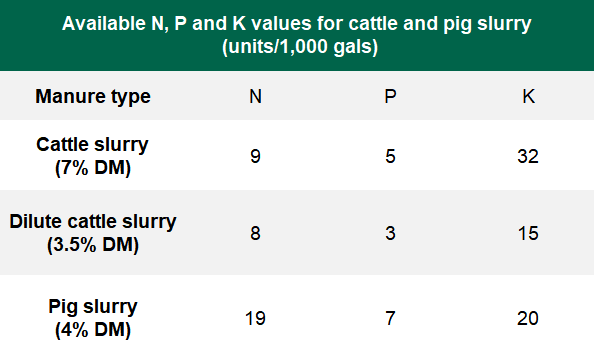By Mark Plunkett, Teagasc soil and plant nutrition specialist
Grass silage has a large nutrient demand and adequate nitrogen (N), phosphorus (P) and potassium (K) are essential for maximising grass yield and producing sufficient winter feed.
N is the key driver of grass yield. Grass swards with high levels of perennial ryegrass will use N more efficiently than older swards.
Recently reseeded swards (zero-to-three years) will have 25% higher N demand – especially when reseeded after a tillage rotation. A crop of grass silage (5t/ha of DM) will require 125 kg N/ha (100 units/ac).
Grass silage will take up on average 2.5kg/ha/day of N (2 units/day); therefore, apply N at least 50 days before cutting to ensure full crop N utilisation.
Make adjustments for fertiliser N applied for early grazing. For example, assume ~25% of N applied will be available for the silage crop. For example, where 40 units/ac of N were applied for grazing, reduce N applied by 10 units/ac for the grass silage crop.
P and K are essential to maximise grass yields; therefore, adequate supply of these nutrients in the soil is critical.
Consult the most recent (three-to-five years) soil test reports to determine the P and K requirements (in organic manure and fertiliser) for silage fields. A crop of grass silage will remove approximately 4kg of P/t and 25kg of K/t of grass DM.
Organic manures are an effective source of N, P and K and can provide a large proportion of crop P and K requirements at a relatively low cost.
Organic manures
Cattle slurry is the most common manure applied to silage fields and can vary in nutrient content depending on its dry matter (DM) content.
Diluting cattle slurry with water is beneficial for ease of agitation and can help to improve the N availability in the slurry.
However, it will also dilute the P and K content of the slurry (i.e. a larger quantity of diluted slurry will be needed to supply the same levels of P and K as undiluted slurry).
The slurry hydrometer is a useful tool that can be used to assess the DM percentage of slurry, helping you to predict the nutrient content more accurately and adjusting application rates.
For example, 3,000 gallons/ac of good-quality cattle slurry (7% DM) will supply sufficient P and K levels to grow a crop of grass silage.
Maximum K application 90kg of K/ha (in springtime)
Luxury amounts of K may be taken up by grass where more than 90kg/ha of K are applied. This can reduce fertiliser K efficiency and may upset the K:Mg:Na balance in herbage.
Where more than 90kg/ha is advised, only 90kg should be applied in spring and the remainder to the aftermath or in late autumn.
Timing of N, P and K application
Apply crop N, P and K requirements when closing silage fields in early April. Where cattle slurry is applied, delay the top-up fertiliser applications for one week.
In wetter soil conditions, fertiliser N can be split 50:50. For example, 50% in early April and the remainder seven-to-10 days later to reduce the risk of N losses.
Building soil P and K in silage fields
Apply additional P and K (soil build-up rates) to index 1 and 2 soils after first-cut silage in late summer.
For example, 16% P or 50% K or 0-7-30 are very suitable fertilisers for building soil P and K levels to the target index 3 over a number of years. Slurry and farmyard manure (FYM) can replace fertiliser where available.
Don’t forget sulphur
Sulphur (S) deficiency is most likely on light sandy, free-draining soils with low soil organic matter.
Current research shows that S deficiency is not just confined to light textured soils and S deficiencies are occurring on heavy textured soils in early spring.
Grass silage crops have a requirement of 20kg of S/ha per cut. The application of S to soils where it is required will improve grass DM yields and quality as it helps to maintain an optimum N:S ratio and N to be used more efficiency.
Apply S with main N split as N +S (e.g. CAN + S / Urea +S).



